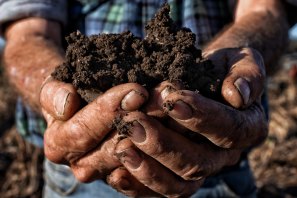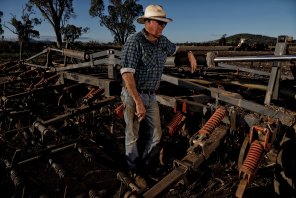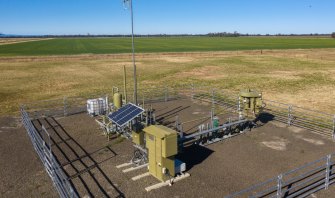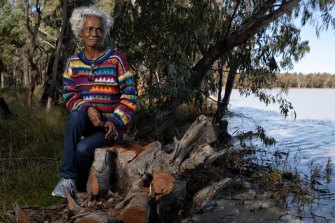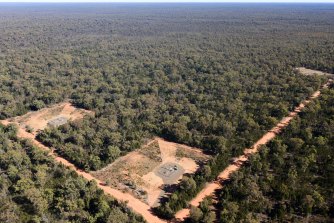By Tim Barlass
Afarmer’s gnarled hands. Black, volcanic farming soil that is so fertile it can produce two crops a year. Cotton, wheat or sorghum, whatever you want. To some it’s dirt but to Scott McCalman, on the Liverpool Plains south-west of Tamworth, it is “incredible”.
He explains its water retention properties, scuffs the earth with his boot and eulogises about the Great Artesian Basin. Then there’s the shallower aquifers that the roots of his crops benefit from. Even in a drought.
Farmer Scott McCalman on his Liverpool Plains property north-west of Gunnedah.Credit:Nick Moir
A fifth generation farmer of 1150 hectares, the former Scots College student speaks with authority as the holder of two degrees from Sydney University in rural science and business management.
One issue. His property near Gunnedah, south of Narrabri, is covered by a recently renewed Santos coal seam gas exploration licence.
He is concerned that drilling could cause contaminated water to seep through natural faults and fissures into the aquifer he depends on.
“Every property has bore water and that’s the last thing we want to risk,” he says. “It is just absurd that the government would even consider it. We just can’t believe that in 2022 they’d even be thinking it.”
One hour north of Gunnedah is Narrabri and its gas reserves in the Pilliga Forest. There, a maximum of 850 new wells are seen as a mid-term solution to the power generation fiasco that resulted in blackout warnings across NSW last week.
McCalman’s property near Gunnedah, south of Narrabri, is covered by a recently renewed Santos coal seam gas exploration licence.Credit:Nick Moir
So great was last week’s energy supply crisis that the Australian Energy Market Operator suspended the east-coast electricity market to restore calm to the grid. A staged approach to lifting the market suspension began on Thursday.
With more than two months of winter ahead and the Ukrainian war affecting Russian gas supply, NSW Premier Dominic Perrottet and federal Resources Minister Madeleine King both see the Narrabri gas project as key to the future security of energy generation.
Perrottet said: “We are completely committed to Narrabri and working with Santos to get that project off the ground.”
King said: “If Narrabri meets all the environmental standards, and by all accounts it does, then it makes sense for it to go ahead.”
But their plans have reignited what has been a long-running conflict over the gas extraction proposals with protest from the highly organised Lock the Gate organisation as well as land owners, farmers and First Nations peoples.
Georgina Woods, national coordinator for Lock the Gate, said Santos and other gas companies “had been exploiting the high gas prices and tight market they engineered to exert political pressure for more damaging gas fields for years”.
Meanwhile, legal debate, including a claim from the Gomeroi traditional owners, rumbles on like Dickens’ fictional probate case Jarndyce and Jarndyce in Bleak House.
Four “zombie” sites where petroleum exploration licences (PEL) had expired have been revitalised since Easter. Santos last week advertised in the local press saying later this year it plans to conduct “low impact, non-intrusive” exploration activities including seismic surveys on public roads and road reserves to the south-west of Gunnedah. The company held an information session in the town on Thursday.
Santos, the second-biggest energy company on the ASX with a valuation of approximately $25 billion, has for more than a decade been on the scene in Narrabri. It has a high street shopfront presence and last year launched the Festival of Rugby in the town and upgraded the Dangar Park sports ground with broadcast-quality stadium lighting and wi-fi connectivity into the clubrooms.
On a tour of Santos operations around Narrabri we stop at an experimental well called Brigalow Park 1. Cereal, legume, sheep and cattle farmer Peter Gett has had three wells here on his property for 10 years.
A coal seam gas well on farmland owned by Peter Gett near Narrabri.Credit:Nick Moir
“Not a drama at all,” he says. “They [Santos] have been very good. They can’t put a foot wrong because the government will make it very hard for them and the media coverage over anything would be covered quicker than the speed of light. I would be happy to have more wells.”
A CSIRO report, Assessment of sub-surface faults as potential connectivity pathways in Narrabri, released last month examined regional geological formations and structures and their relationship with important groundwater resources.
It states: “Geophysics indicate the presence of some faults and fractures which could act as potential pathways for movement of water and gas but no prima facie evidence for this connectivity was observed.” The Gas Industry Social and Environmental Research Alliance (GISERA) has already approved further research.
Assessing the economic benefits, CSIRO found the project could generate 170 direct jobs in the gas sector and could help the establishment of local manufacturing. Locally available gas could also facilitate the establishment of a fertiliser plant employing around 100 people.
There are 26 management plans covering issues like noise, dust, Indigenous issues and heritage still to be signed off before Santos decides to start operating up to 850 wells. The company is optimistic that will happen by the end of the year. More information on reserves is also needed to underpin the multibillion-dollar investment. There is also the issue of annual compensation payments to land owners for “surface disturbance and loss of quiet enjoyment” which the company says carried some Queensland farmers through the drought.
At Bibblewindi No.2, a 10-year-old well head, there’s a slight noise of gas flowing when you get close. The whole well is contained within a fenced-off area about half the size of a basketball court. The gas – which is 90 per cent methane – rises to the surface under its own pressure. Santos says there is no need for fracking in Narrabri.
There’s a solar panel that powers the electrics enabling control of the well remotely and allowing it to be shut down if there’s a problem. If a bushfire came through the company says the well would default to shut down.
Water goes to treatment ponds where it is converted by a process called reverse osmosis into brine and clear water. The Rural Fire Service avails itself of free water. Santos has its own cows that graze in paddocks irrigated by the water.
Water treatment dams for the brine removed from drill sites on the edge of the Pilliga.Credit:Nick Moir
A very small quantity of water is also used by apiarists in the Pilliga (there are lots of them) who get a free supply for their bees. The brine is high in bicarbonates and discussions are ongoing with a company to produce bicarbonate soda.
What of flaring? The flame you see burning all the time with all sorts of emissions? That is a feature of oil rigs, but not coal seam gas, Santos says. We pass a flare vent, but there is no flame. It only ignites if a well has to be shut down for maintenance so that the gas can be purged rather than stored with the associated fire risk. Santos estimates a flare might burn gas once a month for 15 to 20 minutes.
Scientists point out that flaring is not the issue with coal seam gas. Rather it is the invisible “fugitive” emissions leaking from the system that pose a serious threat to the climate. A paper released last year by an international team of scientists funded by the United Nations Environment Program found that with coal seam gas production, for every unit of gas produced, 0.44 per cent of methane was released into the atmosphere. Flaring converts methane to carbon dioxide plus water, which reduces the global warming potential of releasing methane.
We arrive at Wilga Park Power Station, five minutes drive from Narrabri. You can’t see or hear it from the road. Of the 16 wells in the Narrabri Gas Project area, eight are running today. They supply five terajoules of gas daily to six V20 Jenbacher engines, which generate 22 megawatts of electricity at the Wilga station, sent to the grid and supplying 23,000 households.
Gomeroi elder Aunty Polly Cutmore at Yarrie Lake, a culturally important local site in the Pilliga.Credit:Nick Moir
Gomeroi traditional owners have voted overwhelmingly to reject coal seam gas exploitation in the Pilliga Forest. Undeterred, Santos is seeking an agreement with the broader Gomeroi Nation to establish the project at the land tribunal in Brisbane and expects an outcome “within months”.
Elder Aunty Polly Cutmore, representing the Gomeroi Nation, said mediation with Santos had offered financial and employment insentives. In a two-minute video she says: “Santos, I have visited my communities around in the Gomeroi Nation and I have not met one of my people that wants you in our country. We need our water, our artesian water. That very special water is a gift to us. We have to protect it. And we don’t need a mining company coming in and wanting to destroy. We need them to yaanay, go away. Yaanay out of Gomeroi now.”
Sally Hunter farms 80 acres at Harparary near Narrabri with 300 head of cattle, predominately black Angus. “We are one kilometre from a PEL but the cattle country that we lease is within the exploration licence area,” she says.
“The gas companies are holding us to ransom to bring online their energy sources. It is throwing good money after bad because we are giving two or three companies a level of control and where they only bring online the gas powered power stations when the market hits a certain price.
“My parents were located near Roma [almost 500 kilometres west of Brisbane] and had been on the property 35 years and the gas industry was being developed there in the last 15 years. They had an organic beef certified property, and they took the view that having gas fields on their place would pretty much nullify their organic status, and they didn’t want it, they just wanted to say no, and you just don’t have that right as a land holder and that is such a disempowering position to put you in. In their case it was the straw that broke the camel’s back.
“My mum ended up with severe mental health issues out of it and eight years later she is still putting her life back together. They ended up splitting up and the farm was sold and lives were broken apart really.”
Ron Campbell is serving his second term as mayor for Narrabri Shire Council and runs a waste business in the town. He says he doesn’t belong to a political party.
“The community has been waiting for something to happen for eight years,” he said. “We still have people against it, but I am for it because the opportunities we get here are limited.
A coal seam gas extraction site in Pilliga State Forest.Credit:Nick Moir
“The opportunities are immense for us, to grow our community and to set ourselves up off the back of gas and renewables for the rest of our lives and for generations to come.”
Mark Coulton, federal Nationals MP for Parkes, says with the development of inland rail and for local growth and energy needs in the future the gas is important. “I am confident it is not going to impact on farmers’ water. A lot of misinformation has gone around about the impacts of the [extracted] water, but I have got to trust the science and I think the impact particularly at Narrabri in the Pilliga is minimal at best.”
Santos chief executive and managing director Kevin Gallagher said the company has spent more than $1.5 billion trying to get the gas project developed – a project that is 100 per cent committed to the domestic gas market.
Anti-CSG graffiti on a sign near the Wilga Park Power Station near Narrabri. Santos says there will be no fracking occurring in the Narrabri region.Credit:Nick Moir
He dismissed suggestions the gas project was a foot in the door ahead of wider development and said the upcoming seismic testing around Gunnedah was merely a compliance issue. He said: “We have no current plans whatsoever to drill on any of those permits.”
“If there was less gas than we anticipate being there, then we will have a loss-making project. There’s a lot of gas in Narrabri, I can assure you of that, enough gas to produce 150 terajoules per day into the domestic market for years. We can produce that gas in Narrabri for around $6 a gigajoule, maybe slightly less, with technology advances.”
Dismissing concerns around contamination and emissions, he added: “If there was natural seepage through natural faults and fractures anywhere else it would likely be reduced by us taking the gas out. In Narrabri we have never had fracking as part of our plan despite all the anti-fracking protests. There is no need to frack these wells. Coal has twice the emissions of natural gas and Santos is developing carbon capture solutions for a lot of our projects to reduce those emissions anyway.”
On suggestions the gas could be delivered by 2025, he added: “I would love it to, but what I need there is for the NSW government to give me a pipeline licence. If they want to help us fast-track that process, we can build it as soon as I have the licence. I am unlikely to want to spend too much money given the history of NSW approvals until I know that I can get the pipeline to evacuate the gas to our customers.”
A guide to the environment, what’s happening to it, what’s being done about it and what it means for the future. Sign up to our fortnightly Environment newsletter here.
Most Viewed in National
Source: Read Full Article
